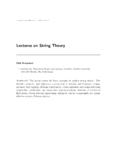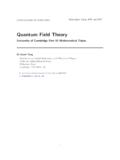Transcription of FUNDAMENTALS OF PHYSICS
1 CONTENTS. CONTENTS. FUNDAMENTALS OF PHYSICS . FUNDAMENTALS of PHYSICS - Volume 1. No. of Pages: 450. ISBN: 978-1-905839-52-0 (eBook). ISBN: 978-1-84826-952-1 (Print Volume). FUNDAMENTALS of PHYSICS - Volume 2. No. of Pages: 324. ISBN: 978-1-905839-53-7 (eBook). ISBN: 978-1-84826-953-8 (Print Volume). FUNDAMENTALS of PHYSICS - Volume 3. No. of Pages: 284. ISBN: 978-1-84826-223-2 (eBook). ISBN: 978-1-84826-673-5 (Print Volume). For more information on e-book(s) and Print Volume(s) order, please click here Or contact : Encyclopedia of Life Support Systems (EOLSS). FUNDAMENTALS OF PHYSICS . CONTENTS. VOLUME I. An Introduction to and Overview of FUNDAMENTALS of PHYSICS 1. Jose Luis Moran-Lopez, Instituto Potosino de Investigaci n Cient fica y Tecnol gica, SLP, Mexico Peter Otto Hess, Instituto de Ciencias Nucleares,Universidad Nacional Autonoma de Mexico (UNAM), M xico 1.
2 Introduction 2. Review of Different Areas of PHYSICS Basic Concepts in PHYSICS Physical Systems and Laws Particles and Fields quantum Systems Order and Disorder in Nature Nuclear Processes Contemporary PHYSICS Future Directions in PHYSICS 3. Economical and Social Implications of PHYSICS 4. Conclusions Historical Review of Elementary Concepts in PHYSICS 25. Peter Otto Hess, Instituto de Ciencias Nucleares,Universidad Nacional Autonoma de Mexico (UNAM), M xico 1. Introduction 2. Newtonian PHYSICS 3. Electricity Magnetism and Optics 4. Thermodynamics 5. quantum mechanics 6. Theory of Relativity 7. Final Remarks Evolution of Elementary Particle PHYSICS in the 20th Century 42. Jorge Flores, Centro de Ciencias F sicas,Universidad Nacional Autonoma de Mexico (UNAM), M xico 1. Introduction 2.
3 Atoms, Nuclei and Radioactivity 3. Ultraviolet and Atomic Catastrophes 4. quantum mechanics 5. quantum Theory of Complex Atoms 6. Nuclear Structure 7. Relativity and quantum mechanics 8. The Force Messengers 9. The Weak Force 10. The Lepton and Baryon Families 11. The Quark Model 12. The Unified Theory 13. quantum Chromodynamics 14. What comes next? Encyclopedia of Life Support Systems (EOLSS) i FUNDAMENTALS OF PHYSICS . mechanics of Solids 60. Ramon Peralta Fabi, Facultad de Ciencias,Universidad Nacional Autonoma de Mexico (UNAM), M xico 1. Introduction 2. Historical Notes 3. General Considerations 4. Classical Theory of Elasticity Beams and Plates Body and Surface Waves The Navier Equations 5. Fracture 6. Finite Elasticity 7. Computational mechanics 8. Granular Materials Electricity and Magnetism 71.
4 Eugenio Ley-Koo, Instituto de Fisica, Universidad Nacional Autonoma de Mexico (UNAM), M xico 1. Introduction General Introduction Electric Charges at Rest Electric charges moving in conductors Permanent magnets and electromagnets Electromagnetic induction Maxwell's electromagnetic field Electromagnetic radiation 2. Electrostatics 3. Electrical Conduction 4. Magnetostatics and Electromagnetism 5. Electromagnetic Induction 6. Maxwell Equations 7. Electromagnetic Waves 8. Concluding Remarks 9. Mathematical Tools Principles of Optics 106. Daniel Malacara-Hern ndez, Centro de Investigaciones en Optica, , M xico 1. Geometrical Optics Fermat's Principle and Law of Refraction First Order Optics Aberrations 2. Wave Optics Diffraction Young's Double Slit Interferometeres and Coherence of Light Sources 3.
5 Photon or quantum Optics 4. Optical Instruments Magnifiers Ophthalmic Lenses Telescopes and Microscopes Medical Optical Instruments Projectors 5. Optical Metrology and Interferometry Main Interferometers Used in Metrology Newton Rings and Fizeau Interferometer Encyclopedia of Life Support Systems (EOLSS) ii FUNDAMENTALS OF PHYSICS . Twyman-Green Interferometer Ronchi and Lateral Shear Interferometers 6. Holography Thin Holograms Thick Holograms Interferometric Holography 7. Lasers Laser Principles Laser Types Laser Applications 8. Applications of Optics Optics in Astronomy and PHYSICS Optics in Medicine and Life Sciences Optics in Industry Optics in Telecommunications Principles of Acoustics 150. Andres Porta Contreras, Department of PHYSICS ,Universidad Nacional Autonoma de Mexico (UNAM), M xico Catalina E.
6 Stern Forgach, Department of PHYSICS ,Universidad Nacional Autonoma de Mexico (UNAM), M xico 1. Introduction 2. History 3. Basic Concepts What is Sound? Characteristics of a Wave Intensity of Sound Pitch Mathematical Description Speed of Sound Doppler Effect Reflection and Refraction Interference and Superposition Standing Waves Timbre, Modes and Harmonics Diffraction 4. The Ear Outer Ear Middle Ear Inner Ear 5. The Applications Ultrasound Medicine Noise Control Meteorology and Seismology Harmonic Synthesis Architecture and Design Speech and Voice Recording and Reproduction Other History of Nobel Laureates in PHYSICS 169. Jose M. Moran-Mirabal, Applied and Engineering PHYSICS ,Cornell University, USA. Kurt Andresen, Applied and Engineering PHYSICS ,Cornell University, USA. Jesse D. McMullen, Applied and Engineering PHYSICS ,Cornell University, USA.
7 Encyclopedia of Life Support Systems (EOLSS) iii FUNDAMENTALS OF PHYSICS . 1. Introduction 2. Atomic and Particle PHYSICS 3. quantum mechanics 4. Condensed Matter 5. Astrophysics 6. Thermodynamics and Statistical mechanics 7. Development of Experimental Methods and Technology On the nature of light and its applications On the insight into microscopic and nanoscopic dimensions On the study of matter through spectroscopy On the study of particles and atoms On the study of atomic magnetism On the advances of technology and our everyday life Laws Of Physical Systems 207. Hugo Garcia-Compean, Centro de Investigaci n y de Estudios Avanzados del IPN, Unidad Monterrey and Centro de Investigaci n y de Estudios Avanzados, Unidad Zacatenco, M xico , M xico. Octavio Obregon, Instituto de F sica de la Universidad de Guanajuato, M xico 1.
8 Introduction 2. Concepts, Theory and Experiments 3. quantum mechanics and quantum Cosmology 4. General Relativity 5. Loop quantum Gravity 6. String Theory 7. M-Theory and Holography 8. Emergent Phenomena 9. Plasmas 10. Thermodynamics and Statistical PHYSICS 11. Complex Systems and Chaos Symmetry Principles and Conservation Laws 230. J. Lorenzo Diaz-Cruz, Benemerita Universidad Autonoma de Puebla, M xico A. Rosado, Benemerita Universidad Autonoma de Puebla, Mexico 1. Introduction 2. Symmetries and Conservation Laws; Noether's Theorem 3. Internal Symmetries in PHYSICS 4. Symmetries and Mathematics 5. Discrete Symmetries: P and C. 6. Isospin and SU(2). 7. The Group SU(3) and the quark model 8. Gauge Symmetries and Fundamental Interactions 9. Symmetry and Observables Special and General Relativity 246.
9 Jorge Pullin, Department of PHYSICS and Astronomy, Louisiana State University, Baton Rouge LA 70803, USA. 1. Relativity in PHYSICS 2. General Relativity 3. Contemporary Developments circa 2004. Encyclopedia of Life Support Systems (EOLSS) iv FUNDAMENTALS OF PHYSICS . quantum Mechanical Laws 255. Bogdan Mielnik, Departamento de F sica,Centro de Investigacion y de Estudios Avanzados, Mexico Oscar Rosas-Ortiz, Departamento de F sica,Centro de Investigacion y de Estudios Avanzados, Mexico 1. Introduction 2. Black Body Radiation: The Lateral Problem Becomes Fundamental 3. The Discovery of Photons 4. Compton's Effect: Collisions Confirm the Existence of Photons 5. Atoms: The Contradictions of the Planetary Model 6. The Mystery of the Allowed Energy Levels 7. Luis de Broglie: Particles or Waves?
10 8. Schr dinger's Wave mechanics : Wave Vibrations Explain the Energy Levels 9. The Statistical Interpretation Polarized Photons: Absence of Deterministic Rules? Born's Statistical Interpretation 10. The Schr dinger's Picture of quantum Theory States, State Superposition, Probabilities quantum Geometry Linear Operators: The Spirit of Interference quantum Observable: Old and New Ideas Observables as Operators: The Anatomy of the Measurement General Formalism; The Extended Born's Hypothesis Functions of an Observable Transition Probabilities: The Most Elementary Statistical Law The Construction of the Traditional Observables 11. The Uncertainty Principle: Instrumental and Mathematical Aspects 12. Typical States and Spectra Harmonic Oscillator: Spectral Ladders, Eigenstates, Coherent States The Angular Momentum Hydrogen and Hydrogen-like Atoms Pauli's Exclusion Principle Particle Spin: A Controversial Non-classical Property The Spectral Bands 13.













